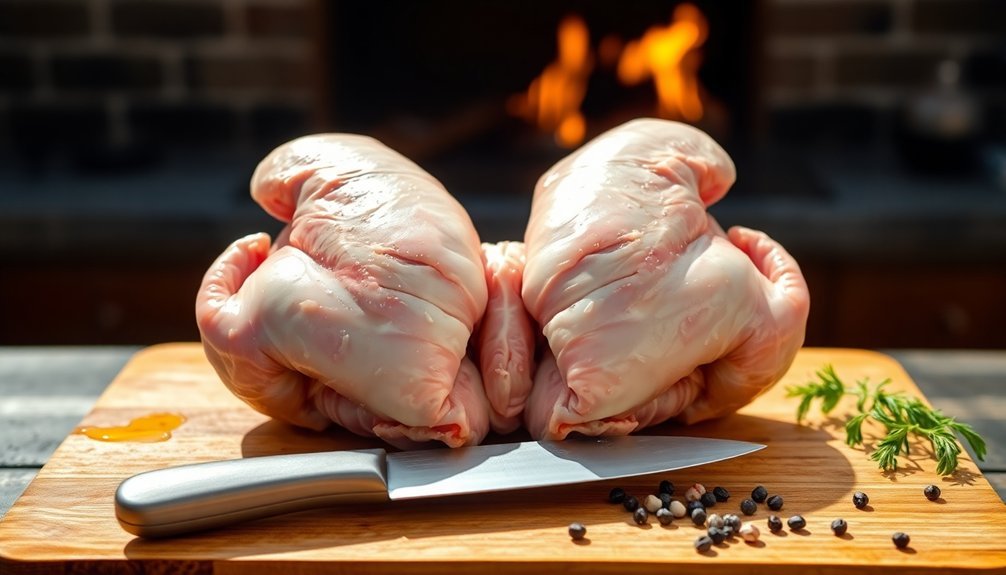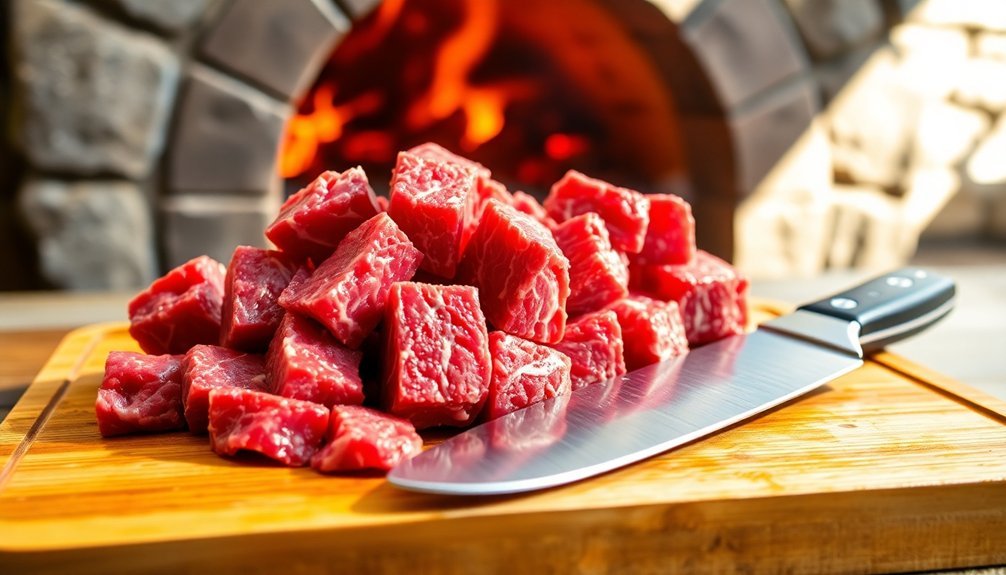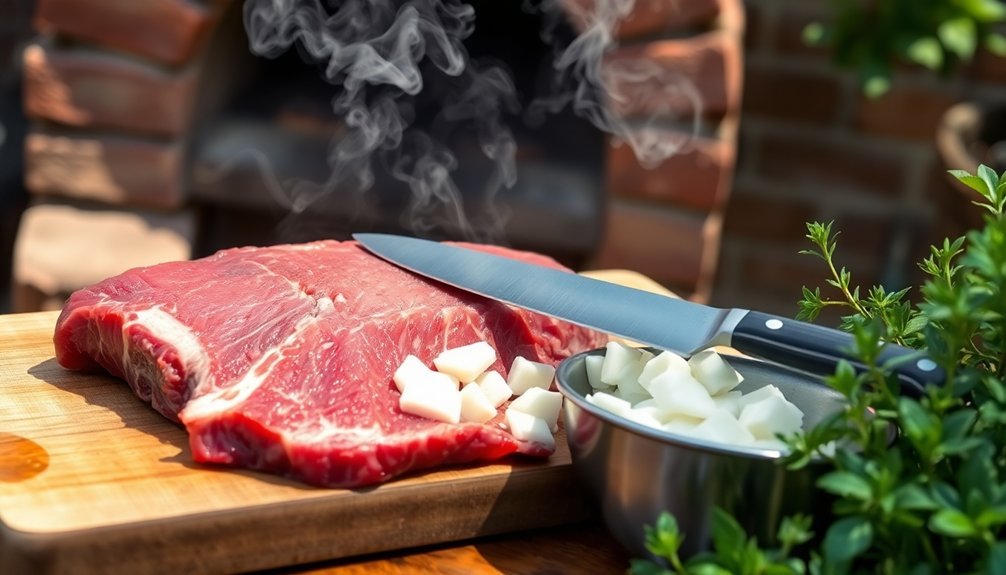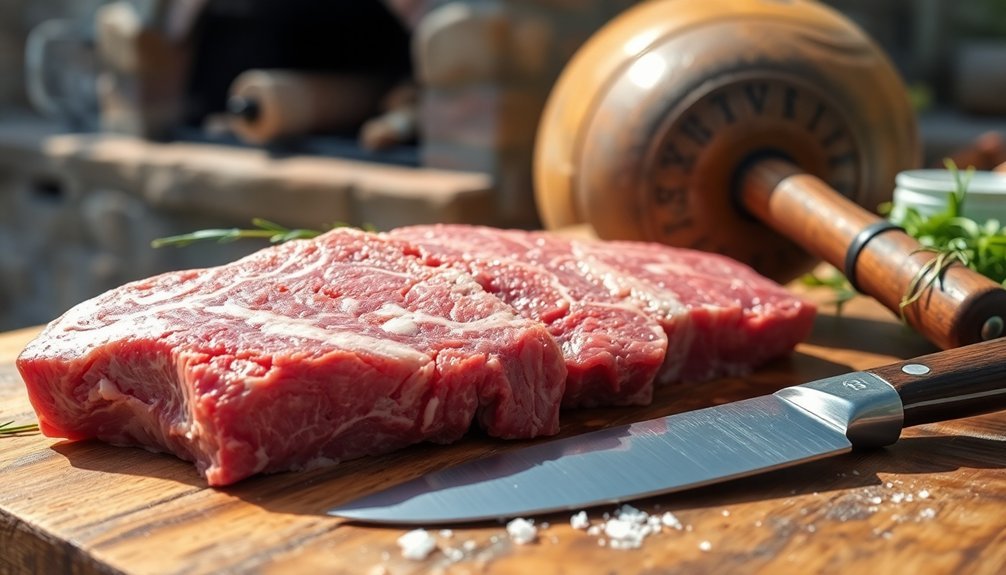Master these seven essential meat-cutting techniques to elevate your outdoor oven cooking. You'll want to butterfly thick cuts for even cooking, slice across the grain for tender results, and cube meat uniformly for perfect kebabs. Don't forget to score your cuts to enhance heat penetration and flavor absorption. For healthier results, trim excess fat carefully while maintaining just enough for flavor. When working with large cuts, portion them appropriately for your cooking needs, and remember to tenderize tougher sections properly. These professional methods will transform your outdoor cooking from basic to exceptional, and there's so much more to discover about each technique.
Butterfly Cut For Even Cooking

A butterfly cut transforms thick cuts of meat into uniform, easy-to-cook portions that are perfect for outdoor ovens.
You'll need a sharp chef's knife or boning knife to execute this technique properly.
To perform the cut, place your meat on a cutting board with its thickest side facing your dominant hand.
Slice through the center horizontally, but don't cut all the way through.
Open the meat like a book, creating a thinner piece that resembles butterfly wings.
This method helps your meat cook evenly and absorb marinades better.
Similar to spatchcocking poultry, this technique promotes even cooking temperatures throughout the meat.
Remember to avoid using dull or serrated knives, which can tear the meat.
Take your time to make precise cuts, and always maintain proper knife angles to protect your fingers.
When done correctly, you'll have perfectly prepared meat for your outdoor cooking adventures.
Cross-Grain Slicing For Tenderness
While butterfly cuts help with even cooking, proper slicing technique determines your meat's final tenderness.
You'll want to identify the meat's grain – those parallel muscle fiber lines – and cut perpendicular to them. This cross-grain method shortens the fibers, making each bite easier to chew. Since the grain becomes less visible after cooking, it's helpful to identify it while the meat is still raw.
For best results when cross-grain slicing:
- Position your meat so the grain runs lengthwise on your cutting board
- Use a sharp knife to make clean, perpendicular cuts
- Slice at a 45-degree angle for increased tenderness
- Keep slices thin, around 1/4 inch thick
- Score tougher cuts before cooking to mark the grain direction
This technique's especially important for cuts like flank steak, brisket, and skirt steak, but it'll improve the texture of any meat you're cooking in your outdoor oven.
Cubing For Kebab Preparation

Cut your meat into precise 1-inch cubes using a sharp knife, maintaining uniform sizes to guarantee even cooking throughout your kebabs.
You'll want to trim excess fat and sinew while leaving about 1/4 inch of fat to keep the meat juicy when it hits the heat. For optimal results, avoid using pre-packaged meat cubes and cut your own from quality cuts.
These consistently sized cubes will absorb marinades effectively and cook uniformly when threaded onto your skewers with small gaps between pieces.
Precise Cutting Techniques
Three key principles guide precise meat cubing for kebabs: uniform size, proper dimensions, and clean cutting technique.
You'll want to cut your meat into 1.5-inch cubes for ideal results, though 1-inch cubes are acceptable for smaller portions. When cutting, use sharp knives to guarantee clean edges and maintain the meat's structural integrity.
- Remove excess fat and sinew before cutting to improve texture
- Cut meat against the grain for tender, easy-to-eat pieces
- Confirm all cubes are consistent in size for even cooking
- Keep meat pieces close but not overcrowded on skewers
- Adapt cutting style based on meat type (strips for chicken thighs, cubes for lamb)
Remember to handle your meat gently while cutting, and store prepared pieces separately until you're ready to thread them onto skewers.
Marinade-Ready Meat Sizes
Proper meat sizing plays an essential role in successful kebab preparation and marination. You'll want to cut your meat into cubes at least 1-inch in size, though 1½-inch cubes are ideal for retaining moisture and preventing overcooking. These larger pieces give you more flexibility with cooking times and help maintain the meat's juiciness.
When you're preparing your kebabs, arrange the meat cubes loosely on metal skewers, spacing them with two vegetable pieces between each cube. This spacing guarantees even cooking and suitable heat distribution.
If you're mixing different meats on your skewers, remember to cut chicken into slightly smaller pieces, or better yet, use separate skewers to accommodate different cooking times.
You'll need about 4oz of marinade per pound of meat for best flavor absorption.
Scoring Meat For Heat Penetration
Scoring meat serves as an essential technique for achieving even cooking and enhanced flavor in outdoor ovens. When you're preparing meat for your outdoor oven, make shallow cuts ⅛ to ¼ inch deep, spaced about ½ to 1 inch apart in a crosshatch pattern. This technique enhances heat penetration and promotes better browning.
- Use a sharp, non-serrated knife for clean, precise cuts
- Score both sides of the meat for prime results
- Create diagonal cuts first, then rotate 90 degrees for crosshatching
- Chill softer meats briefly to maintain control while scoring
- Insert aromatics into scores to infuse additional flavor
Your scored meat will cook more evenly, develop a beautiful crust, and absorb marinades better.
The technique also helps break down tough fibers, making your finished dish more tender and enjoyable.
Trimming Fat For Healthier Grilling

While achieving delicious results from your outdoor oven remains a priority, trimming excess fat from your meat before cooking plays an essential role in creating healthier dishes.
You'll reduce harmful chemicals like HCAs and PAHs by minimizing flare-ups and smoke from dripping fat. Plus, you'll guarantee more uniform cooking throughout your meat.
Start by selecting lean cuts like chicken breast, fish, or choice beef options. When trimming, remove visible fat and skin carefully to avoid cutting away lean meat.
For cuts like brisket, remove the fat and membrane from the flat's top, and don't forget to trim between different sections. Use a fork to rough up the surface afterward for better seasoning adhesion.
These steps will help you maintain flavor while reducing calories and supporting heart health.
Portioning Large Cuts
Smart portioning of large cuts requires both skill and strategy when preparing meat for your outdoor oven.
When you're working with primal cuts like chuck, loin, rib, and round, you'll need to take into account both cooking method and portion size. You'll want to create sections that cook evenly while retaining moisture and flavor.
- Set up dual heat zones on your grill – high for searing, indirect for slow-roasting
- Season generously with dry rubs or marinades to enhance flavor and form a crust
- Sear your portions on high heat first to lock in juices
- Move meat to indirect heat zone for thorough cooking
- Adjust cooking times based on cut size – from 45 minutes for chicken to 6 hours for brisket
Remember to keep your lid closed during most of the cooking process to maintain consistent temperature.
Tenderizing Tough Meat Sections

Once you've portioned your meat, the next challenge is making those tough cuts more tender and flavorful for outdoor oven cooking. You'll need to choose the right tenderizing method based on your cut's toughness. For quick results, use physical tenderization with a meat mallet or score the surface in a crosshatch pattern.
| Cut Type | Tenderizing Method | Time Needed |
|---|---|---|
| Tender Cuts | Light scoring | 5-10 min |
| Medium Cuts | Mallet/needle | 15-20 min |
| Tough Cuts | Marinade/braise | 4-8 hours |
For the best results, combine methods. Start with mechanical tenderization, then marinate tough cuts for several hours. Don't forget to let your meat rest after cooking—five minutes per inch of thickness for steaks, and always slice against the grain for maximum tenderness.
Frequently Asked Questions
How Long Should Meat Rest Before Cutting for Outdoor Oven Cooking?
You'll want to rest your meat for 5-7 minutes for thin cuts and 10-20 minutes for thick cuts. If you're cooking larger pieces, follow the rule of 10 minutes per pound to maintain juiciness.
Which Knives Are Best Suited for Preparing Meat for Wood-Fired Ovens?
You'll want a Messermeister Overland Chef Knife or Wüsthof Classic Carving Knife for wood-fired oven prep. Their high-carbon stainless steel blades and ergonomic handles provide excellent control for slicing raw meat.
Can Frozen Meat Be Cut Directly Before Cooking in Outdoor Ovens?
You can cut frozen meat before cooking, but you'll need to soften its exterior under cold water first. Don't completely thaw it – keeping it partially frozen helps you make cleaner cuts for better results.
Should Marinades Be Applied Before or After Cutting Meat for Grilling?
You'll get better results by applying marinades before cutting your meat. This allows the flavors to penetrate more deeply and tenderize the meat evenly, while also ensuring consistent moisture throughout each piece during grilling.
What Cutting Board Materials Are Safest for Outdoor Cooking Preparation?
For outdoor cooking prep, you'll want to use plastic cutting boards as they're lightweight, dishwasher-safe, and won't absorb bacteria. While hardwood boards are great, they're less practical and harder to sanitize outdoors.
In Summary
You're now equipped with essential meat-cutting techniques that'll transform your outdoor cooking. Whether you're butterflying a chicken for even cooking or scoring a brisket for better heat distribution, these methods guarantee ideal results. Take your time practicing each cut, and you'll soon master the art of meat preparation. Remember to keep your knives sharp and maintain proper safety as you elevate your outdoor cooking game.





Leave a Reply